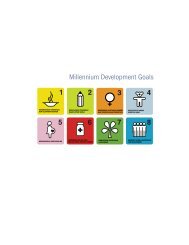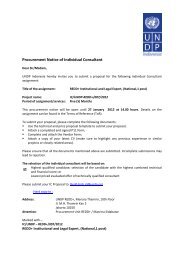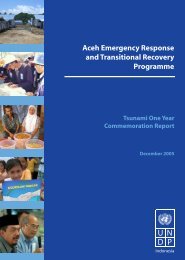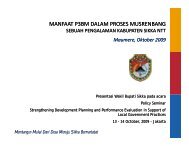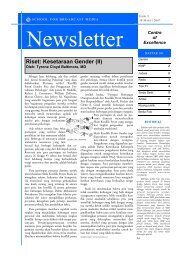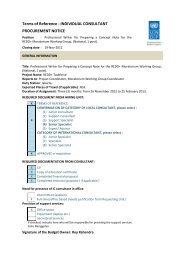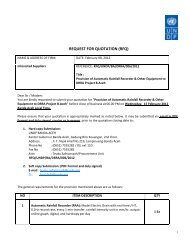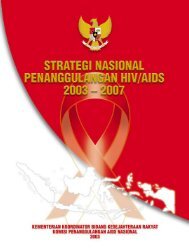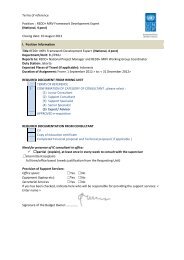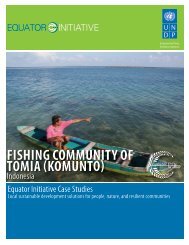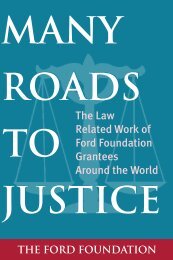(ERTR) Livelihoods Programme - UNDP
(ERTR) Livelihoods Programme - UNDP
(ERTR) Livelihoods Programme - UNDP
You also want an ePaper? Increase the reach of your titles
YUMPU automatically turns print PDFs into web optimized ePapers that Google loves.
<strong>UNDP</strong> EMERGENCY RESPONSE AND<br />
TRANSITIONAL RECOVERY (<strong>ERTR</strong>)<br />
PROGRAMME<br />
LIVELIHOODS<br />
24 - MONTH REPORT<br />
January 2005 - December 2006<br />
www.undp.or.id<br />
Menara Thamrin 8-9th Floor<br />
Jl. M.H. Thamrin Kav. 3, Jakarta 10250<br />
INDONESIA<br />
Ph. +62-21 314 1308<br />
Fax. +62-21 314 5251
<strong>ERTR</strong> Aceh-Nias <strong>Livelihoods</strong> | 24-month Report<br />
<strong>ERTR</strong> Aceh-Nias <strong>Livelihoods</strong> | 24-month Report 3<br />
TABLE OF CONTENTS<br />
EXECUTIVE SUMMARY 3<br />
RESULTS 3<br />
INTRODUCTION 4<br />
PROGRAMME ACHIEVEMENTS 4<br />
1 IMMEDIATE EMPLOYMENT AND INFRASTRUCTURE REHABILITATION 5<br />
2 FISHERIES 7<br />
3 AQUACULTURE 9<br />
4 SMALL ENTERPRISES 11<br />
5 AGRICULTURE AND LIVESTOCK 15<br />
6 TRAINING 16<br />
7 SPORT 19<br />
8 COMMUNITY GRANTS 20<br />
9 ENVIRONMENT 21<br />
10 CHILDCARE CENTRES 23<br />
11 ECONOMIC DEVELOPMENT 23<br />
12 LIVELIHOODS WORKING GROUP 24<br />
E X E C U T I V E S U M M A RY<br />
The overall achievements of the <strong>UNDP</strong> Emergency Response and Transitional Recovery (<strong>ERTR</strong>)<br />
livelihoods programme.<br />
R e s u l t s<br />
54,181 people from 330 tsunami-affected villages temporarily employed through Cash<br />
for Work projects, as a quick response to restore income generation.<br />
525 public facilities cleaned and cleared of tsunami waste.<br />
114 public facilities rehabilitated and reconstructed, including the reconstruction of 3<br />
fishery docks and a mass grave memorial in Ulee Lheue, Banda Aceh.<br />
286 hectares of fish ponds cleared; 16.3 fish pond canals cleared; 311 fish pond gates<br />
reconstructed; 10 hatcheries rehabilitated and reconstructed; and 118 salt ponds made<br />
operational.<br />
16,602 hectares of tsunami waste cleared from community settlements.<br />
4,580 sacks of seed, 400 saplings and 1,553 sacks of fertilizer distributed.<br />
6,310 hectares of agricultural land cleaned and cleared for replanting.<br />
97.8 km of public roads cleared, rehabilitated and reconstructed.<br />
451 km of canals, irrigation systems and drainage systems cleared and rehabilitated.<br />
48 community facilities and infrastructure projects in Banda Aceh, Aceh Besar and Aceh<br />
Barat are being constructed.<br />
Community involvement utilized through Immediate Employment projects;<br />
health/nutrition counselling and education services provided; equipment and tools for<br />
cleaning tsunami debris provided; and reconstruction of houses/communities<br />
completed.<br />
5,554 fishermen received various types of boats, fishing aggregate devices, fishing<br />
gear, and tools and materials for fish processing.<br />
2,600 fishermen benefited from the reconstruction of 3 fishery docks.<br />
7,032 fish pond breeders/farmers received aquaculture inputs, such as feed, fertilizer<br />
and grouper fry to restart income generation.<br />
6,627 small industry and trade ventures re-established through training, replacing<br />
assets, and developing a community group for business development, as well as<br />
providing working capital, micro financing and cooperatives.<br />
1,941 vulnerable people from two sub districts in Aceh Besar provided with community<br />
cash grants to cover their basic needs.<br />
1,773 farmers assisted with seed, fertilizer and farming inputs.<br />
1,447 livestock breeders given animals, including cattle, goats, buffalos, ducks and<br />
chickens.<br />
41 volleyball courts, 12 football fields and 1 basketball court rehabilitated and<br />
reconstructed.<br />
13,600 pairs of football boots distributed throughout the province of Aceh. 50,000<br />
footballs soon to be distributed, all of which were donated by NIKE and Mercy Corps.<br />
7,520 sets of sports equipment, such as equipment for volleyball, badminton and table<br />
tennis, will be given to schools in Aceh.<br />
19,314 Acehnese received vocational/technical, business, agriculture and labour-based<br />
infrastructure training.<br />
261,400 trees planted in an environmental rehabilitation effort.<br />
4 childcare centres reconstructed for 383 tsunami-affected orphans and children.
4<br />
<strong>ERTR</strong> Aceh-Nias <strong>Livelihoods</strong> | 24-month Report<br />
<strong>ERTR</strong> Aceh-Nias <strong>Livelihoods</strong> | 24-month Report<br />
5<br />
I N T RO D U C T I O N<br />
The livelihoods component of <strong>UNDP</strong> <strong>ERTR</strong> Aceh has two main strategies to restore and recover<br />
livelihoods for tsunami-affected people in the Province of Nanggroe Aceh Darussalam (NAD).<br />
The two main programmes implemented include Immediate Employment and <strong>Livelihoods</strong><br />
Recovery.<br />
Immediate Employment through Cash for Work programmes have benefited around 54,181<br />
tsunami-affected people, providing temporary income generation. These projects, which served<br />
around 300 villages in the province of Aceh, are nearly complete. Meanwhile, the <strong>Livelihoods</strong><br />
Recovery <strong>Programme</strong> is being implemented on Aceh's east and west coasts, and on Nias island.<br />
This programme has already benefited 44,347 beneficiaries, helping to restore their lost income<br />
and occupations.<br />
P RO G R A M M E A C H I E V E M E N TS<br />
<strong>UNDP</strong>'s livelihood recovery strategy focuses on the poor and vulnerable in tsunami-affected<br />
communities who need to return to their pre-tsunami income levels to sustain themselves.<br />
Livelihood recovery activities include providing support for the recovery of small enterprises and<br />
trade, fisheries, aquaculture, agriculture and livestock. They also include giving community<br />
grants, recovering sporting activities, providing vocational training, and developing<br />
environment and childcare centres.<br />
<strong>UNDP</strong> <strong>ERTR</strong> gives priority to the recovery of poor and rural communities in restoring lost<br />
livelihoods assets. The programme provides working capital, equipment, tools and goods to<br />
restart businesses. Communities are also given training, cooperatives, seed, fertilizer, materials<br />
and productive assets.<br />
Hasyim's Coffee Shop, Rigaih, Aceh Jaya<br />
Before the tsunami, Hasyim owned a small business<br />
buying and selling locally-grown produce. By saving<br />
what he earned participating in the <strong>UNDP</strong> Cash for<br />
Work programme, Hasyim could afford to build a small<br />
coffee shop in the centre of the vibrant village of<br />
Rigaih, Aceh Jaya. Hasyim even managed propose<br />
to <strong>UNDP</strong> local partner Project Concern International<br />
and other NGOs in the area to provide him with<br />
lumber, tarpaulin and the other building materials he<br />
needed to rebuild his modest lean-to café. These<br />
days Hasyim can be seen found at his café in Rigaih<br />
busying himself making coffee, and selling noodles<br />
and sweets to members of his community.<br />
To ensure that implementing partners and grantees continue to develop sustainable<br />
programmes in Aceh, <strong>UNDP</strong> required them to carry out the sustainable livelihoods assessment.<br />
The assessment was an abridged version of the sustainable livelihood framework, developed by<br />
the United Kingdom's Department for International Development (DFID).<br />
A survey was recently conducted by Syiah Kuala University (Unsyiah) Research Centre to<br />
evaluate the impact of <strong>UNDP</strong> <strong>ERTR</strong> <strong>Livelihoods</strong> Recovery <strong>Programme</strong> on tsunami-affected<br />
people in Aceh. There were 451 respondents, all of who were <strong>UNDP</strong> beneficiaries located in<br />
Banda Aceh and the Aceh Besar district. The study concluded the following:<br />
96.23 percent of respondents agreed that the livelihoods assistance had a positive<br />
impact on their household income.<br />
93.35 percent of respondents used their livelihoods assistance for start-up capital,<br />
equipment, and productive assets to restore their livelihoods.<br />
The current income level of beneficiaries has no returned to their pre-tsunami level. The<br />
high levels of inflation, how ever, has led to bigger expenditures for households.<br />
The research concluded that the income level of <strong>UNDP</strong> beneficiaries has now returned to<br />
the pre-tsunami level.<br />
This two-year progress report is classified into several livelihoods sectors, which <strong>UNDP</strong> has<br />
been implementing since November 2005. The achievements in each sector are as follows:<br />
1. Immediate Employment and intrastructure Rehabilitation 7. Sports<br />
2. Fisheries 8. Community Grants<br />
3. Aquaculture 9. Environment<br />
4. Small Enterprises 10. Childcare Centres<br />
5. Agriculture and Livestock 11. Economic Development<br />
6. Training 12. <strong>Livelihoods</strong> Working Group<br />
1. IMMEDIATE EMPLOYMENT AND INFRASTRUCTURE REHABILITATION<br />
<strong>ERTR</strong>'s initial focus on providing cash<br />
for employment was designed to<br />
immediately assist households in<br />
generating lost income and rehabilitate<br />
public infrastructures and livelihoods<br />
assets. Cash for Work (CfW) was also<br />
intended to be a community gathering<br />
effort, where working together may<br />
promote healing from the trauma of<br />
the tsunami.<br />
Individuals often had higher motivation<br />
to work when they cleaned, rehabilitated<br />
and reconstructed their own villages,<br />
infrastructure and livelihoods assets,<br />
such as fishponds or agricultural land.<br />
Cash for Work project in Pidie clearing fish ponds<br />
CfW projects benefited 54,181 benefited<br />
54,181 beneficiaries, 330 tsunami-affectedvillages, 45 sub districts, and seven districts<br />
in Aceh. Syiah Kuala University conducted an independent impact assessment of 520 workers<br />
from six affected districts who participated in the <strong>UNDP</strong> <strong>ERTR</strong> CfW programme. The<br />
assessment found:<br />
81 percent of respondents agreed that the money gained from CfW covered their daily<br />
needs.<br />
24 percent of respondents were able to save the money from CfW, 39 percent of<br />
whom saved between IDR 250,000 and IDR 499,000.<br />
17 percent of respondents used the money saved to restart small businesses.<br />
83 percent of respondents felt that CfW helped reduce their trauma from the tsunami<br />
disaster.
6<br />
<strong>ERTR</strong> Aceh-Nias <strong>Livelihoods</strong> | 24-month Report<br />
<strong>ERTR</strong> Aceh-Nias <strong>Livelihoods</strong> | 24-month Report<br />
7<br />
The short-term recovery and development activities from the past 24 months are as follows:<br />
2 . F I S H E R I E S<br />
Location Sector Beneficiaries and Result<br />
Bireuen<br />
Banda Aceh<br />
Aceh Jaya<br />
Aceh Barat<br />
Fisheries<br />
Aquaculture<br />
Rehabilitation of<br />
Public<br />
Infrastructures<br />
Income Generation,<br />
i.e. Cash for Work<br />
Aquaculture<br />
Community Health<br />
and Education<br />
Rehabilitation of<br />
Public<br />
Infrastructures<br />
Habitat Restoration<br />
Recycling<br />
Income Generation,<br />
i.e. Cash for Work<br />
Micro grants<br />
Vocational Training<br />
Psychosocial<br />
Outreach<br />
<strong>Programme</strong><br />
Childcare Centres<br />
Villages cleaned 10,227 ha of land and rehabilitated 289.5 km of<br />
tertiary canals.<br />
6,240 CfW beneficiaries.<br />
6.7 km of roads, 9.2 km of drainage systems, and 13.7 km of<br />
housing areas cleaned. 30 public buildings cleaned, i.e. schools,<br />
hospitals, and markets.<br />
23 departments of Zainal Abidin Hospital made fully functional.<br />
Roads and drainage systems in 2 villages opened and cleaned,<br />
and 16,000 plants planted in the villages.<br />
5,211 people in the communities received immediate income for<br />
cleaning the affected areas.<br />
6,079 people employed to clear 18,100 metres of irrigation<br />
channels.<br />
70 ha of rice fields and 209 ha of agricultural land cleared. 4,580<br />
sacks of seed, 400 saplings, and 1,553 sacks of fertilizer<br />
provided. 1 fish auction building, 1 small-scale dockyard and 1<br />
small-scale workshop provided.<br />
A fish auction building and another small-scale dockyard<br />
constructed.<br />
10 boats built and 146 fishing tool sets distributed.<br />
4 Healthcare centres (Posyandu) rehabilitated, 76 Posyandu<br />
cadres trained, and 15 traditional birth attendants trained.<br />
2 Polyclinics (Polindes) constructed, and 1,519 individuals given<br />
health/nutrition counselling and education services.<br />
66 public latrines constructed; 7,200 metres of gravity-flow<br />
water systems, 9 spring water protection units, 6 water<br />
collection tanks, and 3 water supply hand pumps installed.<br />
9 religious schools (Madrasah) rebuilt and 27 teachers trained.<br />
Tools and equipment provided for clearing debris, rehabilitating<br />
structures, and the construction of 63 temporary houses in 45<br />
villages.<br />
3,706 metres of local road renovated, 11 bridges repaired, and<br />
19 Prayer Houses (Meunasah) reconstructed.<br />
23,234 seedlings of casuarinas, mangroves, coconut and sugar<br />
palm trees provided. These seedlings planted along 151 ha of<br />
coastal beach and 6 ha of crop terraces.<br />
18 ha mangrove fields cleared and 60,000 mangrove<br />
plants/seeds planted in three locations in Setia Bakti. 141 local<br />
people participated.<br />
23 cubic metres of wood recycled and 11 villages identified for<br />
developing a timber recycling industry.<br />
31 ha of land prepared for planting, 5,705 metres of drainage<br />
channels rehabilitated, and 2,300 metres of roads cleared by<br />
1,123 local workers.<br />
22 ha farm land cleaned and renovated.<br />
60 ha of village land and roads cleaned and rehabilitated.<br />
2 traditional fish markets constructed.<br />
1 school repainted and cleaned.<br />
125 units of school furniture and facilities distributed in MTSN<br />
Calang.<br />
1,112 km of road cleared, 58.3 km of road restored; 34<br />
mosques, 390 houses, and 12 schools reconstructed. 488 local<br />
people employed.<br />
100 women received a daily income from making school<br />
uniforms.<br />
82 women graduated from vocational training centres.<br />
More than 1,000 community members attended a psycho-social<br />
programme.<br />
19 children enrolled in a childcare centre.<br />
Implementing<br />
Agent<br />
Terres des<br />
Hommes Italy<br />
Panglima Laot<br />
Yayasan Matahari<br />
Yayasan Kata Hati<br />
International Relief<br />
Development<br />
Project Concern<br />
International<br />
Flora Fauna<br />
International<br />
Islamic Relief<br />
Mercy Corps,<br />
Samaritan’s Purse<br />
The fishery industry was the most devastated of all industries in Aceh. Along the east and west<br />
coasts, the fishery industry was brought to a standstill. Along the west coast, almost all boats<br />
were destroyed. Many fishermen and women supplying fishery-support activities were dead or<br />
missing, and many who survived were severely traumatized.<br />
On 20 January 2005, Bappenas (the National Development Planning Agency) reported in<br />
INDONESIA: Preliminary Damage and Lost Assessment that the destruction of fisheries<br />
amounted to almost one-fifth of the total cost of the disaster. The report stated that the<br />
Acehnese lost 64 percent of their boats, a cost equivalent to IDR 190,488 million. They also<br />
lost 66 percent of fishing gear and equipment, equivalent to IDR 161,953 million. Meanwhile,<br />
FAO reported that the disaster took 1,770 boats and destroyed another 896 throughout the<br />
province.<br />
Project Activities<br />
Through the Aceh/Nias <strong>Livelihoods</strong> Recovery <strong>Programme</strong> Round I, <strong>UNDP</strong> collaborated with<br />
government institutions, local NGOs and INGOs to help fishing communities recover their lost<br />
income. The <strong>UNDP</strong> fishery project has helped 8,144 fishermen restore their livelihoods.<br />
In Mesjid Raya, a sub-district of Aceh Besar, the Centre for Coastal and Marine Resources<br />
Studies (CCRMS–IPB) implemented an integrated fisheries project with LEIMA. This project,<br />
titled the Sustainable Coastal Village Development Planning Project (SCVDP), constructed 65<br />
boats of various sizes and functions. These boats were distributed to fishing communities in<br />
three coastal villages [see table below]. The activities supported all 772 households of<br />
Meunasah Keudee, Meunasah Mon and Meunasah Kulam villages.<br />
Boat Types<br />
Number Assisted<br />
Lift-net Boat/Palung 24<br />
Pull Boat/Boat Tarik 24<br />
Beach Seine Boat/Boat Pukat Darat 4<br />
Line Boat/Boat Pancing 10<br />
Mini Purse-Seine Boat/Boat Labi-labi 2<br />
Medium Purse-Seine Boat/Boat Langgar 1<br />
In addition to this project, CCRMS-IPB/LEIMA also provided and replaced three modified Fish<br />
Aggregating Devices (rumpons) in Teluk Krueng Raya, part of Krueng Raya Bay, Aceh Besar.<br />
This type of fishing device is a new technique introduced by a group of experts from the marine<br />
study centre. The device is designed to attract fish in large numbers and is located near the<br />
coastline, making it efficient for small-scale fishermen.<br />
Pidie, Aceh Besar,<br />
Banda Aceh, Aceh<br />
Jaya, Aceh Barat,<br />
and Nagan Raya<br />
Income Generation<br />
Restoration of<br />
Public Facilities<br />
967 ha of land cleaned and rehabilitated by 6,678 people doing<br />
CfW.<br />
58 public facilities cleaned and upgraded.<br />
Islamic Relief<br />
Newly build Palung/bagan [lift-net boat] delivered to fishermen in Krueng Raya [left].<br />
Fishermen celebrate the new boat labi-labi [mini purse-seine boat] and line boats in Panteraja, Pidie [right].
8<br />
<strong>ERTR</strong> Aceh-Nias <strong>Livelihoods</strong> | 24-month Report<br />
<strong>ERTR</strong> Aceh-Nias <strong>Livelihoods</strong> | 24-month Report<br />
9<br />
Similar devices were also provided by <strong>UNDP</strong> implementing partner Terre Des Hommes-Italia<br />
(TdH-I). TdH-I provided 70 rumpons, supporting 933 fishermen in seven sub-districts of<br />
Bireuen. During the emergency period of 2005, TdH-I also assisted 3,410 affected fishermen in<br />
this district to immediately recover fishing livelihoods. They provided fishing nets, fishing long<br />
lining, and materials and shelters for fish processing. Three docks were also rebuilt, which<br />
supported 2,600 fishermen in three sub districts of Bireuen.<br />
Meanwhile, Islamic Relief provided one mini purse-seine boat (boat labi-labi) to a group of 18<br />
fishermen, and five line boats (boat pancing) to 10 fishermen in Panteraja. Islamic Relief also<br />
provided five line boats to 10 fishermen in Kembang Tanjong, and five line boats to 10<br />
fishermen in Kuala Raja.<br />
Jeunieb landing dock built on the river, well protected from<br />
waves causing abrasion from waves<br />
Achievements<br />
A different method of project modality was<br />
implemented by Project Concern International –<br />
Indonesia (PCI). PCI delivered a three-phase<br />
disbursement grant to 24 villages in Lhoong, Aceh<br />
Besar, and to 16 villages in Sampoiniet and Setia<br />
Bakti, Aceh Jaya. The grant disbursed funds to<br />
each community through an established village<br />
team (tim desa). some 341 fishermen received<br />
between IDR 8.5 million and IDR 11 million to<br />
purchase fishing gear and boats as group<br />
belongings.<br />
Community consultation (Duek Pakat) in Krueng Raya resulted in a community-driven charter,<br />
the Piagam Krueng Raya, enabling CCRMS-IPB/LEIMA to establish a cooperative called Koperasi<br />
Syariah Hidup Baru (KSHB) to manage all the deliverables for the project. The cooperative<br />
delivered boats, small grants and trishaws to involved communities, monitored by established<br />
community committees (komite masyarakat).<br />
CCRMS-IPB/LEIMA constructed and delivered 10 lift-net boats (palung) and 10 line boats<br />
through KSHB, and will deliver other boats by the end of this year. <strong>Livelihoods</strong> grants and fishing<br />
gear, such as fish finders and GPS systems, have also been delivered with the boats, which will<br />
enable fishermen to restart their fishing activities more effectively.<br />
Based on a recent survey, a huge number of fish of various types and sizes have aggregated<br />
around the 70 rumpons placed by TdH-I in Bireuen, and the three rumpons placed by CCRMS-<br />
IPB/LEIMA in Teluk Krueng Raya. Fishermen report that the rumpons have helped them catch<br />
increased numbers of fish without venturing too far from the shore.<br />
During monitoring visits, boat recipients in Pidie reported they had restarted their fishing<br />
activities. In Lhong, Sampoiniet and Setia Bakti, the beneficiaries reported to have received all<br />
three phases of disbursements, purchased required supplies, and returned to fishing activities.<br />
Applying the different techniques, CCMRS-IPB/LEIMA in Krueng Raya [left] and<br />
TdH-I in Bireuen [right] have delivered modified rumpon, Fish Aggregating Devices for fishing communities.<br />
Impacts / Effects<br />
The fishing communities gained new knowledge and skills through trainings, such as fish finder<br />
or GPS trainings, provided by <strong>UNDP</strong> implementing partners.<br />
Moreover, group-based work schemes brought about broader results as 'communal-benefiting'<br />
outcomes were absorbed by communities. This, in turn, altered the mindset and attitude of<br />
beneficiaries.<br />
Lessons Learned<br />
Cooperatives should be considered as an exit strategy that promotes project sustainability.<br />
Also, a well-established community-based institution is needed to ensure efficiency beyond a<br />
project completion.<br />
Types of resources available locally should be understood in developing programmes. For<br />
example, some of the parts used by local boat builders are not widely used outside Aceh. The<br />
local boat builders prefer using iron nails rather than galvanized nails. This variance needs<br />
further research and workshops with the fishing community.<br />
Recommendations<br />
Proper impact assessments and surveys of boat populations and fishing capacities have yet to<br />
be completed. These assessments will give a clear description of Aceh's fishery condition, and<br />
provide a foundation to develop a comprehensive strategy for the future to address Aceh's<br />
over-fishing problem.<br />
Fishing communities should be trained with more fish-processing skills, and educated on<br />
market-oriented fish products to stabilize their income level, especially during low seasons.<br />
Also, an easily accessible financial institution needs to be established within the fishing<br />
communities to help manage household finances and provide access to working capital.<br />
3 . A Q U A C U LT U R E<br />
Bappenas reported in INDONESIA: Preliminary Damage and Lost Assessment that the<br />
Acehnese lost 41 percent of their aquaculture assets, worth a total of IDR 466,063 million. The<br />
damage to brackish water culture ponds has been widespread. Even in areas unaffected by the<br />
tsunami, such as in the southern part of Aceh, floods have partially damaged the infrastructure.<br />
It is estimated that the output of the aquaculture industry will fall more than 60 percent.<br />
Previously, Aceh provided a large proportion of the natural Penaeus monodon broodstock for<br />
hatcheries throughout Indonesia.<br />
Project Activities<br />
Located mainly on the east coast of Aceh, ponds (tambak) are one of most valuable sources of<br />
income for the Acehnese, but were heavily damaged as a result of the 2004 tsunami. <strong>UNDP</strong><br />
identified the damaged ponds and delivered support to affected pond farmers, supporting them<br />
in restarting brackish water culture small-scale industry. In total, <strong>UNDP</strong> aquaculture livelihoods<br />
projects assisted 7,032 tsunami-affected fish pond breeders.<br />
<strong>UNDP</strong>, through Terre Des Hommes-Italia, supported 6,388 pond (tambak) breeders with feed<br />
and fertilizer for milkfish and shrimp breeding activities. This covers 134 villages in 10 subdistricts<br />
of Bireuen. In addition, 1.78 million frys, feed and fertilizer were delivered to 650 other<br />
breeders for grouper breeding within seven sub-districts. Fish ponds are one of the main<br />
sources of income for people in the Bireuen District of Aceh. The project began with a needs<br />
assessment, which collected and identified detailed information on damaged ponds prior to the<br />
tsunami. The project implementation then assisted almost 100 percent of the tsunami-affected<br />
fish pond breeders in the district.
10<br />
<strong>ERTR</strong> Aceh-Nias <strong>Livelihoods</strong> | 24-month Report<br />
<strong>ERTR</strong> Aceh-Nias <strong>Livelihoods</strong> | 24-month Report<br />
11<br />
Achievements<br />
Since the project completion, all assisted pond<br />
farmers/breeders started their breeding<br />
activities. Recent data shows that more than<br />
50 percent of the breeders have gathered their<br />
first harvest. The others should also soon be<br />
harvesting, as one breeding cycle process<br />
usually requires four months.<br />
Impacts / Effects<br />
Most breeders have harvested their ponds and<br />
sold their products at market price. The harvest<br />
was partly exported to Medan, Lhokseumawe<br />
and other parts of Aceh. <strong>UNDP</strong> assistance significantly increased breeders' income. For example,<br />
one recent report stated that milkfish breeders earned an average income of IDR 3.1 million, and<br />
shrimp farmers earned IDR 8.2 million per harvest.<br />
Grouper breeders also received increased income from this project. Nearly 90 percent of<br />
fingerlings distributed were successfully sold at the market price of IDR 3,000/fingerling. Per<br />
harvest, beneficiaries received between IDR 1,350,000 for beginners and IDR 2,700,000 for<br />
professional farmers.<br />
4 . S M A L L E N T E R P R I S E S<br />
The Government's Rehabilitation and Reconstruction Master Plan reports that the tsunami<br />
significantly damaged trade and cooperatives. The Central Statistics Bureau (BPS) administered<br />
the Survei Terintegrasi (SUSI) and published the BAPPENAS report about small-scale<br />
unregistered firms. The survey estimates 187,996 small-scale or unregistered businesses<br />
existed in Aceh in 2002, each employing an average of 1.76 people. It is estimated that 80,000<br />
of these enterprises may have been lost, generating job losses of around 140,000 people.<br />
To implement the livelihoods recovery project in tsunami-affected areas, <strong>UNDP</strong> <strong>ERTR</strong> Aceh is working<br />
with several international and national organizations; government agencies (Department of<br />
Industry and Trade), civil societies (with technical support from DFID), International Relief &<br />
Development, Project Concern International, Islamic Relief, PT. Mitra Lingkungan Duta<br />
Consultants, Mercy Corps, and ACDI/VOCA.<br />
Through December 2006, <strong>UNDP</strong> <strong>ERTR</strong> <strong>Livelihoods</strong> component assisted 6,627 small businesses.<br />
These have been re-established with several methodologies, such as assets replacing, training,<br />
providing working capital, developing community groups of businesses, providing microfinance<br />
and developing cooperatives. The involvement of the Department of Industry and Trade<br />
(DISPERINDAG) in Banda Aceh, Aceh Besar and Singkil has been very helpful, especially in<br />
increasing programme sustainability and building local government capacity.<br />
Project Activities and Achievements<br />
<strong>UNDP</strong> and its implementing partners delivered the following activities to help restart the small<br />
enterprise and trade sector. The results achieved are as follows:<br />
1. International Relief and Development (IRD)<br />
This implementing partner was active in five sub districts: Meuraxa and Kutaraja in<br />
Banda Aceh Municipality; Baitussalam and Leupung in Aceh Besar; and Johan Pahlawan<br />
in Aceh Barat. These five sub districts were in the area most damaged by the 2004<br />
tsunami. Through this activity, <strong>UNDP</strong> assisted 2,598 small businesses. Grants of<br />
US$150 to US$250 and were rewarded to beneficiaries through small business<br />
management training. This was conducted in an IRD training centre for three days.<br />
Through monitoring and evaluation and business feasibility analysis by <strong>UNDP</strong> and IRD,<br />
successful businesses were rewarded with additional working capital.<br />
Pond farmers receive distributed nets and frys [left]; while in Alue Kuta, Jangka sub district, the farmers had their first harvest on November 8, 2006 [right].<br />
Lessons Learned<br />
Positive project results were experienced because local communities, government departments<br />
and stakeholders were all fully involved from the initial assessments onwards. Also, transparent<br />
identification of beneficiaries and distribution of assistance contributed to the positive project<br />
results. All inputs to beneficiaries need to be discussed with them thoroughly to avoid<br />
unnecessary assistance. Close collaboration with related local government departments (Dinas<br />
Perikanan dan Kelautan) is valuable for capacity building and programme sustainability.<br />
Recommendations<br />
Comprehensive and integrated aquaculture programmes should be put in place. One complete<br />
training package should be delivered to pond farmers for post-harvest processing. While Aceh<br />
contributes significantly to Indonesia's aquaculture industry, the province has no experts,<br />
experience or infrastructure for post-harvest processing activities. In the future, further training must<br />
be provided for farmers, and the private sector must be involved for better production and marketing.<br />
Abdul Jamil, is a resident of Merduati, Kutaraja sub district. The tsunami took away his family<br />
and belongings, but it did not destroy his hope. He registered with the <strong>UNDP</strong> programme and<br />
joined the small business management training with his brother. He managed to restart the small<br />
business he owned before the tsunami, selling petroleum by the roadside in a small kiosk. He<br />
became successful, and expanded his kiosk into a larger grocery store. Abdul's outgoing nature<br />
has attracted a lot of regular customers, including other kiosk-owners buying goods for their<br />
kiosks located in several areas outside Banda Aceh. Abdul has received an additional grant for<br />
his successful business management.
12<br />
<strong>ERTR</strong> Aceh-Nias <strong>Livelihoods</strong> | 24-month Report<br />
<strong>ERTR</strong> Aceh-Nias <strong>Livelihoods</strong> | 24-month Report<br />
13<br />
2. Project Concern International (PCI)<br />
PCI's project activities were located mainly in Aceh Besar and Aceh Jaya, along the west<br />
coast of Aceh. 270 micro grants for businesses start-ups were distributed to 40 villages<br />
in three sub districts. The activities were conducted through a partnership with local<br />
NGOs, which served as community facilitators working closely with community<br />
empowerment groups (called village teams) in each village. Assessments, beneficiary<br />
selection and working capital disbursements were conducted within a transparent<br />
mechanism through community discussion and evaluation. The programme assisted<br />
businesses in many sectors, such as trading, sewing, cake-making, motorcycle workshops,<br />
coffee shops and restaurants.<br />
6. CCMRS – IPB<br />
Becaks parked at the mechanic shop before distribution to beneficiaries.<br />
In the fishing community of Krueng Raya, <strong>UNDP</strong> collaborated with the Centre for Coastal<br />
and Marine Resources Study – Bogor Agriculture Institute to assist 10 fish traders with a<br />
complete package of mobile fish-and-goods trishaws. This assistance was executed<br />
through a community cooperative established for and within three communities in the<br />
villages of Meunasah Mon, Meunasah Kulam and Meunasah Keudee. Through <strong>UNDP</strong><br />
capital injection, 54 additional small businesses have been assisted. This assistance<br />
came through a cooperative, along with technical assistance and close supervision from<br />
the implementing partner.<br />
3. Austcare<br />
Beneficiaries of small business grants are maintaining their livelihoods through a sewing business<br />
and coffee shop in Lhong, Aceh Jaya.<br />
Austcare's project was active in rehabilitating brick factories affected by the tsunami in<br />
three villages in Aceh Besar. 40 brick factories were fully rehabilitated and granted hand<br />
tractors, buffalos for traditional brick processing, and brick printing machines. Some<br />
470 people (owners and workers) were able to return to their income-generating activity.<br />
To sustain the programme and its impact to the local community, three local<br />
cooperatives were established, and the revolving fund should be able to support more<br />
livelihood activities and other types of community livelihood projects in the future.<br />
Brick producers in a tsunami-affected brick kiln in Lampeudaya<br />
village, Aceh Besar, are grateful of brick printing machine granted<br />
to them. It helps increase the quality and quantity of the bricks<br />
they are producing<br />
5. PT Cagar Gigantara/Surabaya Service<br />
4. Islamic Relief<br />
As many as 1,656 small businesses in Banda<br />
Aceh, Pidie, Aceh Besar, Aceh Jaya, Aceh<br />
Barat and Nagan Raya were re-established<br />
through the implementation of grants and<br />
small business management training by<br />
Islamic Relief. A total of 710 were assetreplacement<br />
projects, and 946 businesses<br />
were given assistance through a revolving<br />
fund mechanism managed by local NGOs<br />
as the subcontractors of Islamic Relief. The<br />
local NGOs were intensively trained and<br />
closely supervised by Islamic Relief to sustain<br />
the mechanism for future community development<br />
programmes in Aceh.<br />
This project targeted poor trishaw (becak) drivers in Banda Aceh. Many becak<br />
drivers were affected by the disaster because they lived on the coastline of Banda<br />
Aceh municipality. A total of 150 trishaws were purchased and distributed to four<br />
becak associations.<br />
7. Supporting Small Industry and Trade in Banda Aceh, Aceh Besar and Singkil<br />
Supporting Small Industry and Trade is a project implemented by <strong>UNDP</strong> to provide<br />
complete equipment, tools and goods for the small industry and trade sector. The project<br />
is conducted through close collaboration with the Department of Industry and Trade<br />
(DISPERINDAG) in Banda Aceh municipality, Aceh Besar and Aceh Singkil. In each<br />
district, DISPERINDAG completed the needs assessment, selected the beneficiaries, and<br />
completed the monitoring and evaluation. <strong>UNDP</strong> then hired a contractor to do the<br />
procurement, distribute the equipment and tools, and conduct the training for the<br />
beneficiaries if needed.<br />
Currently, 1,623 small businesses have received a package of equipment, tools and<br />
goods to restart their business in Banda Aceh, Aceh Besar and Aceh Singkil.<br />
Banda Aceh - Collaboration with the Department of Industry and Trade provided<br />
assistence in re-establishing 361 small industries (cake makers, embroiderers, tailors,<br />
carpenters, bakeries, rattan industries, etc.) and 127 traders (small grocery kiosks in six<br />
sub districts in Banda Aceh). Beneficiaries received equipment, tools and goods through a<br />
consultant selected by <strong>UNDP</strong>, PT. Mitra Lingkungan Dutaconsult.<br />
This family-run home<br />
industry of Acehnese<br />
herbs and spices was<br />
totally destroyed by<br />
the tsunami. Sayed<br />
Hasan's wife and two<br />
o f t h e i r c h i l d r e n<br />
disappeared in the<br />
disaster. Sayed and his<br />
two surviving sons<br />
continued the business<br />
after receiving grant<br />
equipment from this project. “My biggest gratitude is to <strong>UNDP</strong> because I have received this<br />
equipment, which is even better than what we had before the tsunami”, said Sayed. “We can<br />
now catch up on our production since orders have returned to normal. There are even requests<br />
from outside Indonesia”. Part of Sayed's house, unaffected by the tsunami, is now used as the<br />
new factory. With their patience and hard work, Sayed and his sons plan to further increase, by<br />
employing mode people from the community.
14<br />
<strong>ERTR</strong> Aceh-Nias <strong>Livelihoods</strong> | 24-month Report<br />
<strong>ERTR</strong> Aceh-Nias <strong>Livelihoods</strong> | 24-month Report<br />
15<br />
Aceh Besar - The same programme was implemented in Aceh Besar, with ACDI VOCA as<br />
<strong>UNDP</strong>'s implementing partner. The programme and DISPERINDAG Aceh Besar helped<br />
restart 806 small businesses in 52 villages and eight sub districts in Aceh Besar.<br />
Individual beneficiaries and groups received grants in the form of equipment.<br />
L a m c o k v i l l a g e i n<br />
Lhoknga, Aceh Besar, was<br />
one of the communities<br />
that benefiting from this<br />
project. It was famous<br />
for its rattan industry<br />
before the tsunami.<br />
Almost all the women in<br />
the village are skillful of<br />
making rattan products for<br />
sale. <strong>UNDP</strong> has assisted<br />
them through equipment<br />
grants and a building for<br />
use as a shop for all their<br />
products.<br />
Aceh Singkil - This is a district mostly damaged by the 28 March 2005 earthquake. This<br />
district is located in a remote area on Aceh's southwest coast. A similar process was<br />
implemented to assist the earthquake-affected businesses in this area. <strong>UNDP</strong>, PT. MLD<br />
Consultant, and DISPERINDAG Aceh Singkil successfully assisted 338 small businesses<br />
with productive equipment, tools and goods.This project will be finished by December<br />
2006 and is expected to assist more than 700 beneficiaries.<br />
5. AGRICULTURE AND LIVESTOCK<br />
Damages caused by the tsunami and earthquake were mainly concentrated on Aceh's western<br />
and eastern coastal areas, where most of the agricultural land was affected. In some places, the<br />
tsunami travelled up to 5 km inland. The west coast's agricultural areas were badly affected,<br />
especially those located up to 4 km inland from the coast line. It is estimated that 23,330 ha of<br />
rice fields and 22,785 ha of rain-dependent cultivated land were damaged. BAPPENAS reported<br />
that large job losses occurred in agriculture, where about one-fourth of cash crop areas and rice<br />
fields were damaged. A similar percentage of all farms are likely to be unoccupied – affecting an<br />
estimated total of around 320,000 people.<br />
<strong>UNDP</strong> livelihoods component, in collaboration with NGOs, has also taken serious action to<br />
revitalize tsunami-affected agriculture and livestock farms in Aceh. Projects were mainly<br />
located along the west coast of Aceh, where much of the agricultural land and livestock was hit<br />
hardest by the tsunami. At present, <strong>UNDP</strong> has assisted 1,773 farmers ranging from ginger,<br />
crops, rice, watermelon, mushroom and chilli farmers. In addition, 1,447 livestock breeders<br />
benefited through the distribution of cattle, goats, buffalos, ducks and chickens.<br />
<strong>UNDP</strong>, through its implementing partner Lambrineu Foundation, helped 196 ginger farmers in<br />
Aceh Besar to plant 70 tons of Elephant ginger seeds. This covers 35 ha, over 10 villages in<br />
Lhoknga sub district, Aceh Besar. <strong>UNDP</strong> also supported the farmers with bulb wire,<br />
ploughing/harrowing services and fertilizer. Before the tsunami, ginger from Lampaya Village,<br />
LhokNga, was popular in Banda Aceh and in the whole province of Aceh.<br />
At the same time, Project Concern International (PCI) supported 1,054 farmers to plant food<br />
crops such as rice and peanuts on 750 ha of land in Lhoong, Aceh Besar, Sampoiniet and Setia<br />
Bakti, Aceh Jaya. In addition, PCI also supported livestock recovery for tsunami-affected<br />
people in three sub districts in Aceh Jaya by giving goats, cattle and buffalos to 146 groups of<br />
farmers, or a total of 1,347 beneficiaries.<br />
Lessons Learned<br />
Two years after the tsunami, many programmes have been implemented in Aceh. Assisting<br />
small to medium businesses during the emergency period was mainly to give immediate support<br />
to people gaining back their livelihood. Grant systems, both cash and equipment, was very<br />
suitable during this period, even for those who started a different business than what they had<br />
before tsunami. Most of those who managed to establish get a business opened a small kiosk,<br />
and most continue to maintain them well. Failure has been caused by incidents such as grants<br />
that are too small, the wrong type of equipment, and/or project implementers lacking strategy<br />
or knowledge about market needs. Another problem surfaced when beneficiaries were only<br />
trained in how to manage their cash flow, while the businesses they started overlapped with<br />
many other businesses. There should be an orientation for beneficiaries to help them determine<br />
the needs around them, including the sustainability potential for their businesses.<br />
Recommendations<br />
Based on the lessons learned above, it is clear that the beneficiaries who have received grant<br />
distributions in the emergency period should be monitored to determine their further needs.<br />
Often, because of the small amount of funds received, additional assistance from <strong>UNDP</strong> is<br />
needed, this time in larger amounts and distributed through a different system. Those who<br />
continue their business, for example, and need assistance for expansion should be directed to a<br />
micro-finance programme.<br />
A farmer on a hand tractor ploughs a community-run's cultivation field for ginger farming in Lhoknga [left].<br />
In Lhoong, Aceh Besar, two women are planting rice [right].<br />
Mercy Corps Indonesia (MCI) assisted farmers through a community grants programme by<br />
giving 15 hand tractors to farmers' groups and community groups in 14 communities in four<br />
sub districts in Aceh Barat. This programme increased the work capacity and the productivity of<br />
the area's rice fields.<br />
<strong>UNDP</strong>, with Islamic Relief, supported 300 farmers with peanut seeds and fertilizer; 18 farmers<br />
in Aceh Jaya with a watermelon and mushroom project; and 182 households of rice and chilli<br />
farmers in Pidie. Islamic Relief also organized the distribution of 100 cattle to 100 households in<br />
Aceh Besar, Aceh Jaya and Aceh Barat. In Trienggadeng, Pidie, 1,610 ducks were distributed<br />
to 23 beneficiaries, as well as 230 kg of cattle fodder and 46 sachets of vitamins.
16<br />
<strong>ERTR</strong> Aceh-Nias <strong>Livelihoods</strong> | 24-month Report<br />
<strong>ERTR</strong> Aceh-Nias <strong>Livelihoods</strong> | 24-month Report<br />
17<br />
Poultry assisted by Islamic Relief in Johan Pahlawan, Meulaboh [left], and<br />
cattle distributed in Krueng Raya, Aceh Besar [right].<br />
IRD Community Capacity Building in Baitussalam and Leupung sub districts, Aceh Besar, [left].<br />
Baitul Qiradh is a local partner of micro financing under ILO [right].<br />
Lessons Learned and Recommendations<br />
It is difficult to see the results of the agriculture programme quickly because of challenges in the<br />
field, such as viruses in the soil and the long harvesting time for some crop varieties. For<br />
example, ginger takes nine months to harvest. Problems with cattle diseases should also be<br />
anticipated. Animal husbandry training is also crucial for new breeders to promote<br />
understanding of the local environment and climate conditions.<br />
6 . T R A I N I N G<br />
Overview<br />
Due to the catastrophe, many survivors lost all their assets and became unable to resume their<br />
previous activities. Similarly, because of the nature of the disaster, former fishermen may not<br />
want to return to their previous income-generating activity. Therefore, new vocational skills<br />
training was needed. In collaboration with ILO and some INGOs as implementing partners,<br />
multiple training activities were made available. For example, vocational training activities,<br />
small business management, and other livelihoods-related training were all provided. These<br />
trainings were provided after consultations with the local authorities, the private sector, and the<br />
ILO-managed Employment Service Centres.<br />
Project activities/achievement<br />
<strong>UNDP</strong> has tried to encourage individuals to restart their livelihoods by giving them free training<br />
on how to start and how to manage cash flow in their new business activities. Some 18,960<br />
people from tsunami-affected areas and community groups have been trained in a number of<br />
areas, including small grants, small businesses, micro finance, agriculture, fisheries and livestock.<br />
Other trainings have focused on management skills, vocational training and technical skills,<br />
life skills, cooperative management, micro enterprises, and labour-based intensive infrastructure<br />
development. These trainings were conducted throughout the affected districts in Aceh, all under<br />
one of four components: Employment Service, Vocational Training, Enterprise Development<br />
and Microfinance, and Labour-Based Infrastructure Rehabilitation and Reconstruction.<br />
Through the Employment Service Project for the People of Nanggroe Aceh Darussalam (ESP-<br />
NAD), jointly supported by ILO, <strong>UNDP</strong> helped empower job seekers with English skills. This is<br />
part of an effort to improve the skills of Aceh's people, particularly in Banda Aceh, Calang,<br />
Meulaboh, Pidie and Lhokseumawe. This project is also an instrument to speed up the<br />
reconstruction and rehabilitation process through the placement of skilled job seekers. In<br />
total,6,086 people completed this training. Its effectiveness was implied by Dermawan, a<br />
graduate from the English training held in Meulaboh. After the training, Dermawan reported to<br />
his English teacher that he was recruited by Muslim Aid and is now working in Banda Aceh.<br />
Several <strong>UNDP</strong> drivers were also recommended by ILO after they attended the course.<br />
Another component is Vocational Training. In collaboration with ILO, <strong>UNDP</strong> supported 2,958 tsunami<br />
survivors in five tsunami-affected districts. Islamic Relief, a <strong>UNDP</strong> partner for Cash for Work Round<br />
4, reported that 1,000 people were trained for income-generating activities in five tsunami-affected<br />
districts along the east and west coasts. Through Samaritan's Purse, <strong>UNDP</strong> provided a short sewing<br />
course for 82 women in Meulaboh. In addition, the Lambrineu Foundation helped improve understanding<br />
of ginger farming practices for 196 farmers in Lhoknga sub district, Aceh Besar.<br />
Also, Enterprise Development and Microfinance provided free training to individuals, groups, local<br />
NGOs and local government agencies. These groups are connected with <strong>UNDP</strong> in livelihood<br />
sectors such as fisheries, agriculture, livestock, and industry and trade. In 22 villages in Banda Aceh,<br />
3,550 people were trained in small business management by International Relief Development (IRD).<br />
Of those trained, 1,150 people had their capacity increased for medium-level businesses and<br />
became ready to find job opportunities. At the same time, ILO had a clear strategy to provide<br />
more in-depth technical assistance to a limited number of Micro Finance Institutions (MFI),<br />
specifically to replicate the efforts to others in the future. It became important to identify a key<br />
financial partner, particularly with a focus on promoting micro leasing.<br />
Furthermore, in two sub districts in Aceh Jaya and one sub district in Aceh Besar, community<br />
health and education capacity was strengthened in 112 communities. This helped rehabilitate and<br />
reconstruct villages and communities after the huge disaster. Project Concern International (PCI), a<br />
<strong>UNDP</strong> implementing partner for <strong>Livelihoods</strong> Round I, continued to support livelihoods rehabilitation<br />
in 44 villages in Lhoong, Aceh Besar, Setia Bakti and Sampoinit, Aceh Jaya. During the project<br />
implementation process, 1,006 farmers were trained in various agriculture sciences. 1,339 small<br />
business owners were supported with a grant after being qualified through business management<br />
training. Also, 216 fishermen were strengthened with fishing capacity and equipment.<br />
Austcare delivered training to 69 people from two different professions: brick kiln owners and<br />
cooperative staff and managers. In the fishery sector, Alisei trained 53 fish-pond farmers during<br />
their Cash for Work programme, funded by <strong>UNDP</strong>. Similarly, 555 fishermen were trained in<br />
immediate skill needs. This knowledge could be used to restart their pre-tsunami profession,<br />
such as fisheries processing technology, mobile market device or cooperative management.<br />
Business and small industry management training sessions for beneficiaries, which were supported with IRD business inputs [left].<br />
A workshop facilitated by ACDI/VOCA on management, leadership, business and database for Aceh Besar Industry and Trade Department staff [right].
18<br />
<strong>ERTR</strong> Aceh-Nias <strong>Livelihoods</strong> | 24-month Report<br />
<strong>ERTR</strong> Aceh-Nias <strong>Livelihoods</strong> | 24-month Report<br />
19<br />
A total of 13 local NGOs, two Industry and Trade Departments, and five community<br />
cooperatives became the local partner of several <strong>UNDP</strong> implementing partners. As a result, they<br />
were revitalized and strengthened in areas such as organizational management, accounting and<br />
business ethics. These local institutions are now prepared to ensure the sustainability of the<br />
enterprises <strong>UNDP</strong> re-established, and carry on the development efforts by applying newlygained<br />
knowledge and expertise. Specifically within the livelihood recovery projects<br />
implemented by IRD and PCI, three members of each village were supported by the project.<br />
These individuals were selected by their communities and given training. Later, they helped<br />
their communities identify needs and worked with the implementing partners to distribute<br />
assistance.<br />
The last component was the Labour-Based Infrastructure Rehabilitation, implemented by ILO.<br />
216 male and female engineers, technicians and contractors from the Public Works of Aceh<br />
Besar received theoretical, contract management and on-the-job training on road rehabilitation.<br />
No Sector Training Activity<br />
Number of<br />
Beneficiaries<br />
District<br />
Implementing<br />
Partner<br />
some business management trainees, while others are still surviving and need more financing<br />
and marketing support.<br />
Problems and Lessons Learned<br />
A long list of problems and lessons learned was identified by <strong>UNDP</strong> implementing partners<br />
and/or monitors. The capacity of targeted participants was much lower than originally<br />
estimated; therefore, greater efforts were required than previously planned. There was a lack of<br />
understanding of what cooperatives stand for and how they can help promote democratic<br />
values to a community at large. ILO also pointed out that the coordination mechanism, originally<br />
launched by ILO, eventually lost its momentum and coordination became less apparent, while in<br />
some cases competition became the norm.<br />
Recommendations<br />
To address these issues, the implementing partners made a few recommendations. For<br />
example, follow-up technical support is required; focus on outreach for capacity building<br />
training; clearly determine strategic alliances; and focus on capacity y building for Disnaker in<br />
labour relations and labour administration. The participants also offered some<br />
recommendations. For example, to divide participants into two groups: those with a business<br />
and those without, or beginners. This division will make the training more targeted and allow<br />
trainers to focus on entrepreneurship concepts and assess new business ideas for potential<br />
entrepreneurs. Also, the owners of existing businesses can go into more depth about actual<br />
business management skills. In addition, extra support should be provided to the younger target<br />
group to increase the likelihood of business start-up. Extra attention should be provided in<br />
targeting women and supporting women's businesses. This support is necessary as women's<br />
businesses tend to be smaller than men's, and some women are more vulnerable as lone<br />
breadwinners for their family because of the tsunami.<br />
7 . S P O R T S<br />
Post-tsunami, significant construction assistance was directed towards rebuilding schools,<br />
houses, roads and health facilities. Assistance to rehabilitate other community facilities,<br />
especially sporting facilities, was limited from local and international NGOs. Few NGOs<br />
designed a special programme to restore the sports sector as a tool for trauma healing for<br />
tsunami-affected youth.<br />
Dinas Pemuda dan Olahraga (Dispora), the government authority overseeing sports and youth<br />
issues, identified damaged sporting facilities in 12 districts in Aceh and intensively searched for<br />
assistance to rehabilitate these facilities. In many communities in Aceh, volleyball and football<br />
are major sports, played by men and women.<br />
<strong>UNDP</strong>, in partnership with Dispora Aceh Province, took a special initiative to rehabilitate and<br />
reconstruct 89 sport facilities. A Letter of Agreement was signed by both parties to initiate the<br />
activities. To date, <strong>UNDP</strong> has reconstructed and rehabilitated 41 volleyball courts, 12 football<br />
fields and one basketball court.<br />
Impacts<br />
A number of impacts were observed. For example, more workers became qualified to enter the<br />
workforce of Aceh's emerging reconstruction and rehabilitation effort. Those trained for work<br />
placement became linked in and were recommended to NGOs. The overall reconstruction<br />
process was accelerated because organizations could identify workers relatively quickly and<br />
found access to qualified workers. The pre-tsunami economic level was effectively regained by<br />
Project Activities<br />
1. Sports Site Reconstruction<br />
<strong>UNDP</strong>, through HOPE International, agreed to rehabilitate 89 sport facilities in 12<br />
tsunami-affected districts. 46 sports facilities were rehabilitated, including 35<br />
volleyball courts, 11 football fields and one basketball court. Close consultation and
20<br />
<strong>ERTR</strong> Aceh-Nias <strong>Livelihoods</strong> | 24-month Report<br />
<strong>ERTR</strong> Aceh-Nias <strong>Livelihoods</strong> | 24-month Report<br />
21<br />
participation with the communities were made in reconstructing the sports facilities.<br />
Workers were recruited from community areas to strengthen community participation.<br />
stakeholders, a block grant<br />
distribution system in 19 villages<br />
was established to provide cash<br />
grants to the vulnerable groups,<br />
such as widow groups, elderly<br />
groups and orphanages. These<br />
grants of IDR 50,000 - IDR<br />
375,000 were to be used for daily<br />
needs such as food, health care,<br />
school kits and basic house<br />
equipment. A total of 1,941<br />
people were assisted by this<br />
activity.<br />
Widows, the elderly and orphans in Baitussalam were in line<br />
to receive cash assistance for health and education needs.<br />
The volleyball court under construction in Desa Meunasah Mon, Mesjid Raya, Aceh Besar [left].<br />
Youth playing basketball on a rehabilitated court in Lampriet, Banda Aceh [right].<br />
2. Distribution of Sports Equipment<br />
In November 2006, <strong>UNDP</strong> procured 7,520 sets of sports equipment for schools in 12 affected<br />
districts in Aceh. The equipment included:<br />
3,500 volleyballs<br />
630 volleyball nets<br />
200 table tennis tables<br />
800 table tennis paddles<br />
600 boxes of table tennis balls<br />
800 badminton rackets<br />
190 badminton nets and 800 tins of shuttlecocks<br />
Lessons Learned<br />
It is not easy to monitor the flow of cash distributed to groups, as the amount is not big and<br />
most of the money is used for daily needs, health care and educational needs. The impact is not<br />
very visible because the cash is spent quickly. Also, while beneficiaries feel it is a big help, the<br />
disbursement design is not sustainable. This type of project should not be maintained in the long<br />
run to avoid dependency on cash grants. Instead, vocational training for vulnerable groups,<br />
such as young orphans and widows, are needed to ensure future livelihood capabilities. The<br />
establishment of grant communities is very important for the transparency of beneficiaries. In<br />
addition, the involvement of female representatives is necessary to represent and identify the<br />
needs of vulnerable women in the community.<br />
9 . E N V I R O N M E N T<br />
8 . COMMUNITY GRANTS<br />
Overview<br />
The 2004 tsunami left a high number of vulnerable groups in Aceh, such as young orphans,<br />
widows, widowers and elderly people with dependants. <strong>UNDP</strong> tried to assist these vulnerable<br />
tsunami survivors through a community grants programme implemented by International Relief<br />
& Development (IRD).<br />
Project Activities and Achievements<br />
This programme was implemented through working together with established Community Self-<br />
Help Groups (project focal points) in 19 villages in the sub districts of Baitussalam and Leupung,<br />
Aceh Besar. Each committee is comprised of three village representatives who were appointed<br />
by their communities using a community meeting structure. These committees, comprised of<br />
57 people from 19 villages, identified vulnerable people from each village they represent. They<br />
also received capacity building training on how to run the project.<br />
Through IRD, <strong>UNDP</strong> facilitated the establishment of a three-person Community Grant<br />
Committee in each sub district, with at least one female representative on each committee.<br />
Each committee had to identify and register the vulnerable groups in the villages: widows,<br />
orphans and the elderly. The committees conducted the registration themselves, a process<br />
acknowledged by village authorities and verified by IRD. In collaboration with community<br />
Overview<br />
Based on the damage assessment produced by BAPPENAS (2005), the earthquake and tsunami<br />
had enormous impacts on Aceh's coastal environment, causing damage and loss of animals,<br />
plants, habitats and important ecosystem functions. Although the extent of damage to these<br />
ecosystems was not confirmed at the time of this assessment, some preliminary results have<br />
been obtained. For example, there was full damage to 25,000 ha of mangroves, which were<br />
already in poor condition, and some 300 km of coastal areas need restoration.<br />
<strong>UNDP</strong> is one of the concerned agencies that gave considerable support to environmental<br />
rehabilitation. For a full recovery, reconstruction and rehabilitation efforts must ensure that<br />
identified needs are met and that the results of recovery activities are environmentally<br />
sustainable. One of the major efforts undertaken was the mainstreaming of ecological issues in<br />
rebuilding livelihoods to ensures long-term sustainability of results for victims of the tsunami<br />
and for generations to come. By integrating ecosystem approaches into livelihood recovery<br />
activities that have been implemented by <strong>UNDP</strong> implementing partners, <strong>UNDP</strong> has helped<br />
prevent conflicts over resource use and reduce negative development impacts, such as<br />
pollution.<br />
Activities/Achievements<br />
Environmental awareness was mainstreamed in all livelihood activities. For example, a new<br />
firing system using rice husks was introduced to replace wood in 40 brick kilns rehabilitated in<br />
Aceh Besar. Community requests for chainsaws from people cutting down trees in the forests<br />
were rejected. Instead, they were taught to value the forest as an environmental resource and<br />
about the anticipated effects if it is destroyed.
22<br />
<strong>ERTR</strong> Aceh-Nias <strong>Livelihoods</strong> | 24-month Report<br />
<strong>ERTR</strong> Aceh-Nias <strong>Livelihoods</strong> | 24-month Report<br />
23<br />
In Setia Bakti, Aceh Jaya, the rehabilitation project for the mangrove forest provided 110,000<br />
mangrove seedlings, which were planted in an area of 12 hectares. As many as 141 male and<br />
female beneficiaries were hired on a contractual basis that paid workers a piecework rate, based<br />
on the number of seedlings planted. This rehabilitation will protect the adjacent villages from<br />
sea winds and recover the habitat for fish breeding, crabs and other creatures.<br />
In Aceh Besar, Islamic Relief planted 1,400 coconut palms, mango and casuarina trees in strand<br />
in the village areas in Lampuuk, Lhoknga. Also, in Pidie, <strong>UNDP</strong> recently planted 150,000<br />
mangroves. This project was a direct request from the community to <strong>UNDP</strong>, as they felt there<br />
was a strong need to have more shady trees planted in their village.<br />
During field monitoring in May 2006, Mahdi, the coordinator of Flora and Fauna (<strong>UNDP</strong><br />
implementing partner) for Setia Bakti sub district, explained that they selected appropriate<br />
mangrove species that are similar to those previously grown in the area. These species are<br />
Soneratia Alba, Rhyzopora micronata and Rhyzopora apiculata.<br />
Impact<br />
The impact of this planting project will only be felt over a longer-term time period. For reasons<br />
still to be ascertained, many of the mangroves in Aceh Jaya have died. However, rehabilitated<br />
mangroves are predicted to give many benefits to the community living close to the area. The<br />
community in Lampuuk, Aceh Besar, now has mango trees planted in their home yards, which<br />
means they will have a much-needed shady area.<br />
Lessons Learned<br />
Some of the projects were based on community requests to <strong>UNDP</strong>. These requests were<br />
forwarded to partners, some of which lacked the technical expertise on coastal plantations,<br />
while having the budget to carry out the proposed activities. Time constraints given by donors<br />
was another major issue faced. Time pressure caused last minute planning, last minute planting<br />
and insufficient maintaining, which affected the plantation growth. Moreover, involving<br />
communities in mangrove rehabilitation has been difficult. This is especially true before they<br />
have their basic needs met, such as housing and a more settled lifestyle. Communities should be<br />
involved in all planning activities to ensure a commitment for future care of the seedlings.<br />
Recommendations<br />
Women in a CfW programme planting mangroves for an FFI project in Aceh Jaya [left].<br />
Islamic Relief, through Cash for Work, planting mangoes at houses in Lampuuk, Aceh Besar [right].<br />
Any future project should have a clear initial assessment, utilize strategic planning, provide<br />
adequate training to all workers involved, and include continuous monitoring and effective<br />
evaluation. The hope of the community is reflected in the perspective from Bang Yung (local<br />
community of Lhok Buya): “I was a fisherman. There were lots of mangroves here before the<br />
tsunami. If I don't want to go to the sea, I just find fish and crab in the mangrove swamp. For<br />
me, if there are mangroves here there will be more fish here. I used to get between IDR 100,000<br />
and IDR 150,000 per day before the tsunami.”<br />
10. CHILDCARE CENTRES<br />
Overview<br />
The tsunami caused deep-rooted trauma among adults and children. A huge number of children<br />
lost their homes and families, depriving them from the love, care and support they need. The<br />
situation also resulted in no or limited access to education and health services. As a result,<br />
intensive trauma-healing activities have been conducted for orphans, as well as representative<br />
care centres opened for orphans and other vulnerable children.<br />
<strong>UNDP</strong>, through the Aceh/Nias <strong>Livelihoods</strong> Recovery <strong>Programme</strong> Round I, worked in<br />
collaboration with local NGOs to construct four childcare centres, which help orphans and<br />
children who were directly or indirectly affected by the tsunami.<br />
Activities/Achievements<br />
Samaritan's Purse constructed a child centre in Meulaboh, serving 19 children who play and<br />
learn while their mothers receive sewing training. In Blang Krueng, Baitussalam, Aceh Besar,<br />
Islamic Relief constructed a representative child centre, which supports 65 children. This fullyequipped<br />
child centre is managed by Syiah Kuala University and <strong>UNDP</strong>. Islamic Relief also<br />
participated by delivering equipment, such as computers, furniture and reading books. To cover<br />
the operational and managerial needs, Islamic Relief contributed funding for the centre for one<br />
year. Islamic Relief also built another child centre in Punge Blang Cut, Jaya Baru, Banda Aceh.<br />
The centre is equipped with furniture and books for 100 children.<br />
A well-equipped childcare centre in Blang Krueng, Aceh Besar [left], and a children's education centre<br />
in Punge Blang Cut, Banda Aceh [right]. Both were constructed by Islamic Relief.<br />
11. ECONOMIC DEVELOPMENT<br />
Finally, in Lamjabat village,<br />
Meuraksa sub district, IRD<br />
supported a local NGO's child<br />
activity centre. This centre<br />
serves 200 affected children<br />
in Meuraksa by providing<br />
continuous payment for<br />
caregivers and teachers.<br />
Meuraxa sub district is a<br />
'ground-zero zone', heavily<br />
damaged by the tsunami, and<br />
with many affected orphans<br />
and children. With activities such as games and studying, the reconstruction of the child centre<br />
may result in trauma healing.<br />
This is a collaboration project between <strong>UNDP</strong> <strong>ERTR</strong> and the Aceh Province Planning and<br />
Development Agency (BAPPEDA ACEH), developed under a Letter of Agreement (LOA) titled<br />
Supporting the Aceh Coffee Forum. This project was designed by <strong>UNDP</strong> and Bappeda to<br />
facilitate a long-term, sustainable economic strategy for the Acehnese coffee industry.<br />
Acehnese coffee has an established reputation for good quality and is well known, especially in<br />
the Netherlands, other parts of Europe and North America. With the return to normality in postconflict<br />
and post-tsunami Aceh, the forum is working to ensure that Acehnese coffee can<br />
regain its formerly well-established place in the world market, and provide long-term income<br />
generation for its growers.<br />
Bappeda NAD has designed a new strategy for the long-term, sustainable development of Aceh<br />
by zoning the local resources produced in certain areas. Coffee is a potential product in certain
24<br />
<strong>ERTR</strong> Aceh-Nias <strong>Livelihoods</strong> | 24-month Report<br />
parts of Aceh, mainly in the Aceh Tengah and Bener Meriah highland districts. A supply chain<br />
study for this commodity was developed by Accenture Development Partnership (ADP) in<br />
collaboration with <strong>UNDP</strong>.<br />
The establishment of the Coffee Forum was recommended by major coffee stakeholders, such<br />
as farmers associations, coffee exporters and government institutions. The forum is a place for<br />
the stakeholders and planners to share recommendations, inputs and strategies to redevelop<br />
Acehnese coffee after the five-year armed conflict. The stakeholders have agreed on several<br />
initiatives recommended from the forum, i.e. rehabilitating land used for coffee, training farmers<br />
and revitalizing research centres and infrastructure. Regular workshops have been conducted<br />
with extensive involvement from the private sector, farmers and government representatives.<br />
To date, the Coffee Forum has successfully recommended to Bappeda Aceh the allocation of<br />
nearly one million USD for coffee development projects in 2006. BRR, INGOs and other donors<br />
have also shown their interest in developing this potential commodity in Aceh.<br />
As the LOA ended in November, <strong>UNDP</strong> signed a new LOA titled Aceh Partnership Economic<br />
Development (APED) to continue assisting Bappeda Aceh in developing coffee and other<br />
potential commodities in Aceh.<br />
12. LIVELIHOODS WORKING GROUP<br />
Coordination is one of the biggest challenges in the implementation of livelihood recovery<br />
projects in Aceh after the tsunami. Overlapping assistance, lack of government involvement,<br />
and insufficiency of assistance are some of the major problems occurring.<br />
In collaboration with Aceh Provincial Level for Social Welfare Department (Dinas Sosial Provinsi<br />
Nanggroe Aceh Darussalam), <strong>UNDP</strong> <strong>ERTR</strong> Aceh established a <strong>Livelihoods</strong> Recovery Working<br />
Group (LRWG) secretariat from April 2005 to November 2006. The working group was given<br />
additional staff through Dinas Sosial volunteers, and provided with a meeting room, furnished<br />
to accommodate LRWG meetings and other events held by Dinas Sosial. Participation in LRWG<br />
meetings increased as NGOs recognized the need to join together with other actors, share<br />
information on government policies, and learn about programmes undertaken by other<br />
organizations in the field.<br />
The LRWG has always been an open forum, held in Bahasa Indonesia and English. It has<br />
included participants from over 50 international, national and local NGOs, as well as<br />
representatives from the government. Since April 2005, the forum has also included the<br />
Rehabilitation and Reconstruction Board (BRR), which was appointed by the central<br />
government. Various initiatives were launched to collect information on project implementation<br />
and support better coordination of activities in the field. This information was managed by the<br />
UN information management provider (HIC) and published on the group's website. The LRWG<br />
mailing list currently has 400 participants registered.<br />
No Sector Training Activity<br />
1<br />
Small and<br />
Medium<br />
Enterprises,<br />
Micro<br />
finance, and<br />
employment<br />
2 Agriculture<br />
3 Fishery<br />
4<br />
Health &<br />
Education<br />
Small business management<br />
training<br />
Cooperative, book keeping<br />
and management<br />
Number of<br />
Beneficiaries<br />
District<br />
4,700 Banda Aceh<br />
Implementing<br />
Partner<br />
International<br />
Relief<br />
Development<br />
407 Aceh Besar ACDI/VOCA<br />
Sewing course 198 Aceh Barat<br />
Micro enterprises 50<br />
Various vocational trainings 2,958<br />
Employment services, e.g.<br />
English courses<br />
Labour-based infrastructure<br />
rehabilitation<br />
Cooperative, book keeping<br />
and management<br />
Vocational training as<br />
provision of incomegenerating<br />
activities<br />
Capacity building in managing<br />
supported businesses.<br />
TOT for NGOs, and training<br />
local communities to improve<br />
SME practices<br />
6,086<br />
445<br />
Banda Aceh,<br />
Aceh Jaya, Aceh<br />
Utara, Aceh<br />
Barat, and Nias<br />
Samaritan's<br />
Purse<br />
ILO<br />
69 Aceh Besar Austcare<br />
940<br />
Pidie, Aceh<br />
Besar, Banda<br />
Aceh, Aceh<br />
Jaya, Aceh<br />
Barat, and Nagan<br />
Raya<br />
40 Banda Aceh MLD<br />
1,339<br />
Aceh Besar,<br />
Aceh Jaya<br />
Ginger farming technology 196 Aceh Besar<br />
Farming and animal<br />
husbandry<br />
Training on mobile market<br />
device and fish processing<br />
technology<br />
Training to improve fishing<br />
infrastructure<br />
Training on ponds and canal<br />
maintenance<br />
Community health and<br />
education<br />
1,006<br />
Aceh Besar,<br />
Aceh Jaya<br />
Islamic Relief<br />
Project Concern<br />
International<br />
Lambrineu<br />
Foundation<br />
Project Concern<br />
International<br />
555 Aceh Besar CCRMS IPB<br />
216<br />
Aceh Besar,<br />
Aceh Jaya<br />
53 Pidie Alisei<br />
112 Aceh Jaya<br />
Project Concern<br />
International<br />
Project Concern<br />
International<br />
5 Livestock Chicken raising 60 Aceh Barat Islamic Relief<br />
Total 19,430



